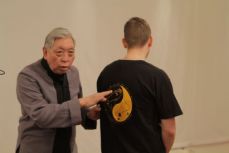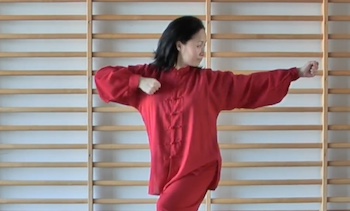Ways to learn Qigong and Taijiquan part 2
There are many ways to learn Qigong and Taijiquan.
We have considered the pros and cons of some:
Learning with DVDs, videos and online-programmes

The promise: If you are very busy, videos and online-classes seem to be for you: your training will be independent of time and place! Just switch your TV/PC on after work and off you go. Or do you prefer the early mornings? No problem!
PRO:
- Online videos are great for a first try if you are not sure what exactly you want to learn. There are many offers for trial courses and introductions. It is the easiest way to access the Chinese arts.
- Additional learning with videos alongside regular courses may be a good schooling for your eyes. Unlike in class you now have time to watch and repeat. – Maybe you will think of some questions, that you can ask your teacher in the next session?
- If you are living very remote or cannot access a school for other reasons, exercising with online-programmes is always better than not exercising at all.
CON:
- Absolute flexibility brings with it the danger to postpone your sessions to infinity: “I will just finish that, and then… aaah, maybe I will do it tomorrow!” … “Oh no, I have to finish the housework first.” – Online-learning requires a special sort of self-discipline, which you may not have.
- Many workspaces and your private life are full of screens and multimedia over-kill. Do you really want to spend the rest of your free time in front of a computer screen instead of going to a class or train Tai Chi in the park? You will miss out on fresh air and happy encounters!
- Ask yourself sincerely: How good is your eye-body-coordination? With online and DVD training, there is no possibility of receiving a feedback. – You might think you do the same movements as on the video, but is it really so? One possibility to correct yourself is using a mirror, but you will need a big mirror with a lot of space in front of it. The small one in the bathroom or the big one in the narrow corridor will not do… – And even then: the front view (2D-picture of your body) and the additional view from the sides (3D-view) may differ. In the long run, you risk moving two-dimensionally and orientating yourself to the front rather than moving in a three-dimensional space. Without a mirror, you might end up doing something else than Qigong.
Anyhow, with good feeling and some luck, you might be able to memorize the choreography and to copy the outer form of the movements correctly. BUT: Qigong and Tai Chi can offer so much more!
- The internal workings of Tai Chi and Qigong are hardly visible from outside – especially not for beginners. The real work begins, when the choreography is memorized and the finer aspects of body mechanics are left to be studied.
If you got that far by learning with a video/DVD or online programme you will have to decide, if this sort of gymnastics/calisthenics (the outside form) is all you need. – Or are you curious for more (e.g. learning guided relaxation of different body parts, effectively restructuring your body or removing ineffective or harming movement patterns)? If so, you will need to find a teacher for some face-to-face lessons.
Ways to learn Qigong and Taijiquan
Part 1: Weekly courses
Part 2: DVDs, videos and online-programmes
Part 3: Workshops – Weekend courses
Part 4: Workshops – Exchange meetings
Author: Taiji-Forum
Images: Taiji-Forum

